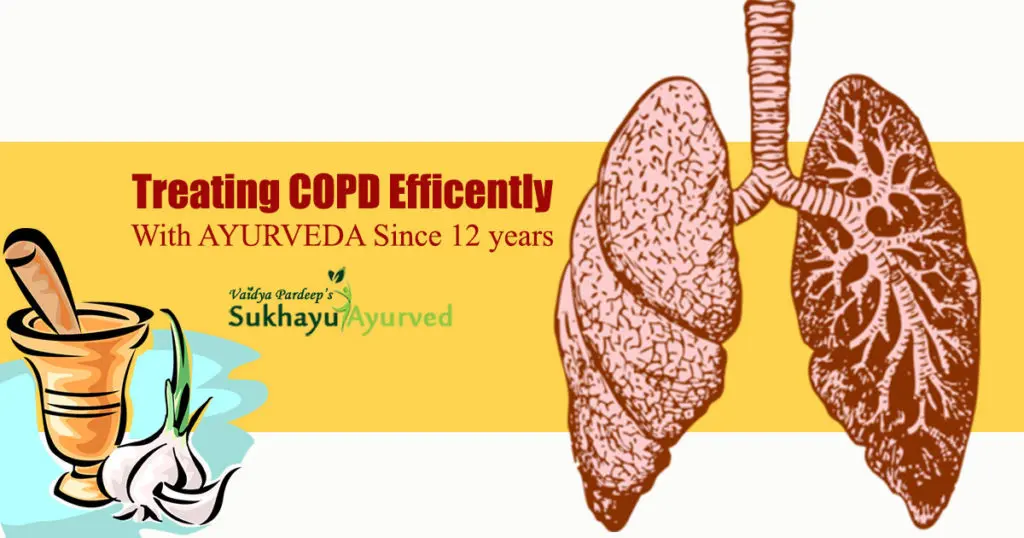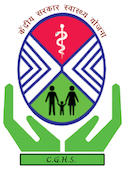
Chronic obstructive pulmonary disease or COPD is a chronic inflammation of lungs that results in obstructed airflow from the lungs. It results in difficulty in breathing, cough, wheezing respiration, and sputum production. Without proper oxygen it becomes hard for system to sustain. Secondly because lungs work with the deep association with heart. And when blood doesn’t move freely between lungs and heart. It makes the things complicated. Conventional medicines doesn’t help much. But Ayurvedic treatment of COPD can help you to live better life. Modern medicines think like machines. But Ayurveda takes on a disease from a living perspective.
COPD develops due to long-term exposure to particular matters such as irritating gas. Smoking cigarettes is one of the most significant causes of COPD. Chronic obstructive pulmonary disease increases the risk of lung cancer, heart diseases and other life-threatening conditions.
Here we will talk about the condition, its treatment and all other aspects one by one.
Facts on Chronic Obstructive Pulmonary Disease
- COPD is a group of progressive lung diseases.
- Many patients suffering from chronic obstructive pulmonary disease suffer from chronic bronchitis and emphysema.
- Western medicine has no cure for COPD.
- Conventional treatment can only alleviate the symptoms and lower the chances of complications.
- If COPD is left untreated, it results in faster progress of the disease, or worsens respiratory infection and results in heart problems.
- Diagnosis of COPD involves a blood test, imaging test, and lung function tests.
- More than 6.1 people across the globe suffer from moderate-to-severe COPD.
- Chronic obstructive pulmonary disease is likely to increase in the coming years due to the prevalence of higher smoking, pollution, and the aging population in many countries.
- It is believed that more than and 90% of COPD that occurs in developing and underdeveloped countries is due to smoking, poor ventilation, and fumes of cooking fuel.
- Chronic obstructive pulmonary disease reduces the quality of life severely.
- However, smoking is one of the leading causes of COPD; still, one in four people suffering from this disease may not smoke.
Symptoms of Chronic Obstructive Pulmonary Disease
Symptoms of chronic obstructive pulmonary disease include:
- Persistent cough
- Excessive production of mucus
- Breathlessness, especially after getting exerted.
- Fatigue and lack of energy
- Tightness in chest
- Wheezing respiration
- Frequent respiratory infections
Symptoms get worse in more severe cases. Severe COPD also includes:
- Shortness of breath even while talking
- Blue tint of fingernail beds and lips
- Lack of mental awareness and alertness
- Rapid heartbeat
People experiencing mild symptoms of COPD may not consult a doctor. This is why many cases of COPD remain undiagnosed until the disease becomes severe.
The chronic obstructive pulmonary disease leads to the following complication if left untreated:
- Lung cancer
- Recurrent respiratory infections for example pneumonia
- High blood pressure
- Heart problems
- Unintended weight loss
- Malnutrition
- Swelling in feet ankles and leg.
- The inability to live an active life leads to depression
The above complications may prove to be fatal. This is why it is imperative to take proper treatment and preventive measures during the early stages of the disease.
Stages of COPD
The chronic obstructive pulmonary disease progresses through four different stages depending upon the result of forced expiatory volume test or FEV1. The result of the forced expiratory volume test determines how much air the patient get expel in a single second from the lungs.
Stage 1 – Stage 1 is a very mild form of chronic obstructive pulmonary disease. There is a very slight airflow limitation. Symptoms are usually absent. However, the patient may feel short of breath while climbing a hill or walking fast. The FEV1 test results of 80% or more of a healthy person.
Stage 2 – It is a moderate form of COPD. In this stage, the patient begins to seek medical help for symptoms such as shortness of breath, wheezing respiration, and coughing. At this stage, even if you are walking on a levelled ground, you may need to stop every few minutes to catch a breath. The FEV1 result of 50% to 80% of a healthy person.
State 3 – In this stage, the symptoms such as wheezing breathlessness, coughing, shortness of breath, worsens and the quality of life is affected. The simple dressing makes the patients too short of breath. It even becomes difficult for him/her to leave the house. FEV1 results of 30% to 50% of a healthy person.
Stage 4 – It is a very severe chronic obstructive pulmonary stage. It is the end stage of the disease. The disease progresses up to the point where the functions of the lung is severely limited. This stage proves to be life threatening. The patient might have heart failure or lung failure, and it becomes hard to catch breath even while resting. FEV1 result of 30% or less of a healthy person and those with low levels of blood oxygen but slightly higher FEV1 score.
Causes of Chronic Obstructive Pulmonary Disease
One of the leading cause of COPD is tobacco smoking. About 20 to 30% of chain smokers eventually develop COPD. Poor ventilation and exposure to fumes from fuel for cooking is also a cause.
The causes of airway obstruction
The two main causes of airways obstruction are:
Emphysema – It destroys the elastic fibres and fragile walls of alveoli. When you exhale, the small airways collapse, and the airflow out of the lungs is impaired.
Chronic bronchitis – Here, the bronchial tubes are narrowed and inflamed. The lungs produce more mucus and further narrow the tubes. Because of an effort to clear the airways, the patient develops a chronic cough.
Risk Factors for Developing COPD
- Exposure to tobacco smoke – Cigarette smokers, pipe smokers, marijuana smokers, as well as people exposed to large amounts of passive smoking are at the risk of developing COPD. People suffering from asthma and smoke have an increased risk of developing COPD.
- Occupational exposure to chemicals and dust – Long term exposure dust and chemicals especially at workplace affects the lungs
- Exposure to fumes from the burning fuel – In developing countries, people, and especially females are exposed to the fumes from the burning fuel. Besides, their homes are poorly ventilated.
- Age – COPD develops slowly, so in most of the patients, the symptoms begin at least at or after 40 years of age.
- Genetics – In some cases of COPD, alpha 1 antitrypsin deficiency is the cause.
How chronic obstructive pulmonary disease occurs
To understand how COPD occurs, let us first understand the anatomy of our airways. The air travels from the trachea (the windpipe) into the lungs through bronchi (two large tubes). Inside the lungs, the bronchi divide into many small tubes (bronchioles) that ends in a cluster of alveoli (tiny air sacs). Alveoli have thin walls full of capillaries (tiny blood vessels.
The oxygen we inhale passes into the blood vessels and enters the bloodstream. The carbon dioxide (the waste product of metabolism) exhales.
Our lungs rely on the natural elasticity of the air sacs and bronchial tubes to force the air out of the body. However, due to chronic obstructive pulmonary disease, bronchial tubes lack flexibility and over-expand. Thus, some air traps in the lungs even after you exhale.
Ayurveda About COPD
Ayurveda is a science where we talk a lot about channels. These channels help the body to complete different physiological processes. Lungs are special in this case. Because these present a complete cluster of the millions of channels. These channels work as place for exchange between blood and air.
The bad air, carbon-dioxide moves out and oxygen comes in. And this air is we call as Prana.
Prana is essential for life. And this makes lungs an important place. Because air brings dryness. Therefore a lot of mucus appears and helps to keep the lungs moist.
The same mucus when blocks the passages. There is no space for the air to move. Air traps in. And this trapped air starts ruining the lung tissues.
So there are two things happening side by side. Body doesn’t get proper oxygen. And secondly the dying tissue leads to fibrosis of the lungs. This makes COPD a deadly disease.
Is it about Kapha?
Generally during treatment of such conditions. The basic mistake we make is- we focus on the Kapha. Because place of the disease relates to the place of Kapha. And besides this person spits a lot of phlegm and everybody thinks that this “mucus” is “Kapha”.
But this is Vata. The air. Which comes and goes. And this process keeps us alive.
The Vata traps in. And this Vata needs passage. This passage occludes by Kapha. Because the third one, Pitta brings the inflammatory changes.
So this is something which is important in ayurvedic treatment of COPD.
Ayurveda Treatment for COPD
For the Ayurveda treatment we need to pacify the three doshas. Yes all three Doshas. And that is the only way through which we can bring the positive changes for a patient.
At Sukhayu Ayurved, for the treatment of the condition we follow the same approach. This is not about the removal of the Kapha alone. The thing is all about channelising the air to right direction.
This is only possible when we help the pitta to settle down so that it won’t bring more and more phlegm at the site. This is the way Ayurveda treatment can help the patients to lead a normal life.
The treatment of the condition is all about bringing balance of the three. Therefore the treatment at Sukhayu for COPD works.
How does the treatment for COPD work
The treatment of the COPD is based on medicines alone. In most of the cases patients just need to come to our OPD on regular intervals.
The Ayurvedic treatment for COPD might go for long. This is a condition where a patient needs to continue on least possible medicines. These medicines continue with certain dietary restrictions.
If you are not far away from Jaipur the best idea is to come to Jaipur-
You need to come for extensive physical check up and that too with prior appointment. Patient need to come empty stomach. You can find the details on – Preparing for Ayurveda Consultation with Vaidya at Sukhayu.
If you are far away and need remote help, we have an option for Video Consultation too. You can book an appointment for video consultation.
And after that you need to fill the form for the same from the page onwards.
Be assured, you can get rid of the all possible complications of the COPD and can breathe normally….













